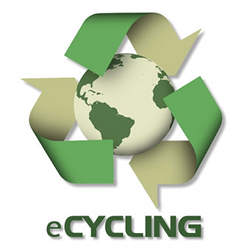
Electronics recycling (e-cycling) has come a long way since the 1990s, with far less hardware being tossed into landfills, or exported in containers to Third World nations where toxic components can pollute soil, groundwater, and (if burned, as often happens) the air.
"There is absolutely a lot less e-waste being dumped in [U.S.] landfills, but the volume is higher,’’ notes Robert Schafer, research director, IT Vendor and Asset Management at Gartner. "The volume in Western countries has gone down because of all the regulations that have come out, and an increasingly strong understanding of the serious consequences."
While it was not uncommon to see toxic waste ending up in landfills as recently as the 1990s, there is far greater awareness now of the need to properly reclaim and recycle electronics and their valuable and/or toxic components among vendors of e-cycling services, users of the equipment, manufacturers, and the governmental bodies that regulate the other three, Schafer says.
The U.S. Environmental Protection Agency (EPA) sees awareness growing of the importance of recycling electronics. "A number of factors contribute to this awareness, including more opportunities for consumers to conveniently recycle electronics, electronics recycling laws, and voluntary efforts by electronics manufacturers and retailers,’’ says EPA spokesperson Enesta Jones.
An estimated 1.9 million tons of selected consumer electronics (including TVs, VCRs, DVD players, video cameras, stereo systems, telephones, and computer equipment) was generated in 2000, but only about 10% was recovered, according to the EPA’s 2011 Municipal Solid Waste in the United States report (MSW). In 2011, an estimated 3.4 million tons of selected consumer electronics was generated, the report states, but 24.9% was recovered, "so we are seeing some progress in the amount of electronics recovered vs. landfilled," Jones says.
A survey commissioned by the Institute of Scrap Recyclers Industry (ISRI) finds the electronics recycling industry is robust and actively growing. While in 2002 there were approximately 6,000 full-time employees in electronics recycling, the survey found that number had increased to approximately 30,000 in 2010.
An ongoing issue is that 28 U.S. states have their own regulations for recycling e-waste; while the EPA offers guidelines, they’re not enforceable. Schafer believes the ideal scenario would be a national standardized e-waste policy, "but given the dysfunction of Washington, that isn’t going to happen."
One of the biggest changes the EPA has seen when it comes to extending the life of used electronics, as well as electronics recycling, is the advent of electronics recycler certification programs. There are two accredited certification standards: the Responsible Recycling Practices (R2) and the e-Stewards Standard for Responsible Recycling and Reuse of Electronic Equipment®. "These programs advance best management practices and offer a way to assess the environmental, worker health, and security practices of entities managing used electronics,’’ Jones says.
Certified electronics recyclers must demonstrate through audits and other means that they meet specific environmental standards and responsibly manage used electronics. Once certified, recyclers are held to the particular standard by continual oversight by the independent, third party accredited certifying body. There are more than 500 electronics recycling facilities that are certified to at least one of these standards, the EPA says.
While Schafer agrees there is a wide range of alternatives for disposing of e-waste in environmentally responsible ways, at the other end of the spectrum are "Joe and his truck," which are "the guys who say ‘don’t worry about it, I’ll pick it up and you can trust me and by the way, I’m half the price of the big guys.’" They then dump the electronics illegally, or ship them off to Third World countries to be buried, burned, or otherwise improperly handled. "That’s still vibrant and that continues to be a challenge."
In the U.S., stronger laws include harsh penalties like jail time for improperly disposing of electronic waste, but the same is not true in Third World countries, Schafer says. "So now, Joe and his truck are shipping the stuff to the Far East and eastern Europe, to a degree; anywhere where laws aren’t as strong or there’s more corruption and you can turn a blind eye with money under the table. It costs money to do this right."
Costs associated with reuse and recycling are determined by several factors, including labor, scrap metal pricing, and the extent to which components can be reclaimed, according to the EPA, which does not track disposal prices.
The biggest e-cycling challenge continues to be "awareness of opportunities for consumers to donate and recycle electronics,’’ says Jones. The EPA offers a Sustainable Materials Management Electronics Challenge, and works with electronics manufacturers and retailers to increase the amount of electronics they collect at end of life, and to ensure these electronics are sent to certified refurbishers and recyclers.
Although opportunities to responsibly donate and recycle electronics at low or no cost are increasing, Jones says consumers are not yet taking advantage of these opportunities "at the level we’d like to see."
Esther Shein is a freelance technology and business writer based in the Boston area.



Join the Discussion (0)
Become a Member or Sign In to Post a Comment